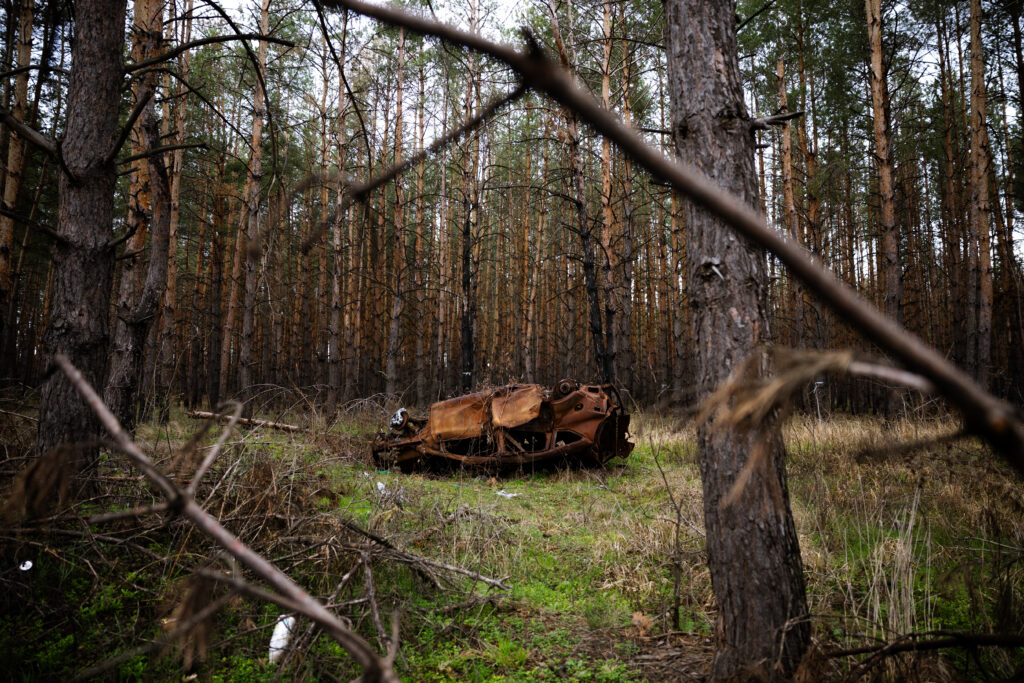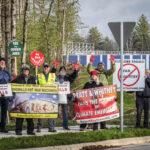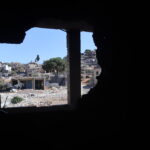In the distance, a mix of thundering booms and piercing reverberations echoed for what seemed like minutes to members of the 49th Assault Battalion of Ukraine’s 66th Mechanized Brigade. The explosions were around 10 kilometers (around 6.2 miles) away, but the intensity of the attack caught the group’s attention.
“It’s probably Lyman,” remarked one soldier, referring to the frequently attacked city 12 kilometers (around 7.5 miles) from the frontline. “Sounds like artillery, mortars, and probably a few KABs,” the term for Russian glide bombs that often devastate Ukrainian positions.
The soldiers were undergoing a training exercise, practicing close-quarters combat in the remains of a house that fighting had half destroyed in 2022. The distant attack, while loud, was nothing out of the ordinary. Although most of the group had already completed rotations at the front, this was their first time training in an urban setting.
“Before, we’ve only trained for trenches and fields, but fighting in cities is much harder,” explained Champ, the group’s instructor. “You’ll see a lot of open windows, and many ways to die.”
A 29-year-old special forces veteran from Kyiv, Champ, who asked to be identified by his callsign, is among the most experienced soldiers of the group. He first fought the Russians in 2014 and has since fought in some of the hardest battles of the full-scale war.
“ Now, we have only two options. We can fight or we die,” he tells me as the guys take a break to smoke. “We can run, but the Russian FSB (Federal Security Service) works in our cities, so we have to keep fighting for our country, for our families, for the Ukrainian language, and for our world.”

*
With Ukraine now in its fourth year of resisting Russia’s full-scale invasion, the contentious return of Donald Trump to the White House has ushered in an era of uncertainty and widespread speculation concerning the longevity of US support for Ukraine.
As much of the recent international coverage of Ukraine has focused on the Trump administration’s erratic actions and proclaimed progress in bringing the war closer to an end, the fighting along the front has continued unabated. In Donetsk Oblast, a frontline region in Ukraine’s east scarred by some of the war’s most deadly fighting, soldiers and humanitarians alike are preparing for a future where peace remains elusive and the Russian attacks continue, despite diplomatic efforts, exhaustion, and hopes to the contrary.
“I think Russia wants to keep fighting; they want more territory of Ukraine, and it won’t stop here. After this, it could be Poland or the Baltic countries, but Putin won’t stop.” Champ said. “He is a dictator, but even if he dies, the Kremlin is not just one man.”
Ukrainian leadership announced on March 11 that Ukraine would participate in a 30-day ceasefire after a meeting in Saudi Arabia with a delegation from the United States, if Russia agreed to do so as well.
“We are one step closer to restoring durable peace for Ukraine. The ball is now in Russia’s court,” stated US Secretary of State Marco Rubio at the time. A week later, Putin offered a partial ceasefire on energy infrastructure, but rejected an unconditional version unless Ukraine ceased to receive foreign military aid and stopped mobilizing new troops. That same day, March 18, Russian drones attacked across Ukraine, including the capital Kyiv.
For the next month, attacks, including on energy infrastructure, continued until Russia announced a 30-hour ceasefire for Orthodox Easter. This ostensible ceasefire did see a pause in Russian air attacks on Ukraine, but fighting along the front continued unchanged. Putin announced the next alleged ceasefire on April 28, which would span the 72 hours surrounding Victory Day on May 9, a Russian holiday commemorating the defeat of Nazi Germany in World War II, and for the Putin government, a highly curated propaganda spectacle celebrating Russian militarism and nationalism. Despite this claimed ceasefire, fighting again continued without pause, nearly two months after Ukraine first announced support for a 30-day ceasefire. Russia has continued to refuse participation.
Throughout this time, the Trump administration insisted that progress was being made, despite repeatedly disparaging the Zelensky government. Meanwhile, Steve Witkoff, Special Envoy to the Middle East, expressed favorable views of Russia’s alleged diplomatic efforts while repeating Kremlin propaganda. On April 23, the US announced a proposal for ending the war that would largely freeze fighting along current frontlines while granting US recognition of the Russian annexation of Crimea, which both Ukraine and Russia rejected. Shortly after the US government and its Ukrainian counterpart agreed on a version of the contentious “mineral deal,” the Trump administration announced that it would no longer attempt to mediate peace talks.

*
Back in Donetsk Oblast, where the guys Champ is helping train are fighting, the brutality of war has only continued, taking a grim toll on soldiers and civilians alike. A mandatory evacuation order for families with children first came in April 2023 if they lived within 10 kilometers (about 6.2 miles) of the frontline. At the end of March, this evacuation order expanded to now include families living within 15 kilometers (about 9.3 miles) of the front.
“This whole media chaos, and the new deadlines and promises from Trump are actually very disruptive, and make our work quite difficult as well because people are hopeful that a ceasefire is coming, and so considering how long they’ve stayed in these areas, they quite often decide ‘Okay, I can wait a couple more weeks or a month’ hoping for a ceasefire, remaining in danger, even if they are ready to evacuate,” explained Anton Yaremchuk, the 35-year-old co-founder of the humanitarian organization Base UA.
The organization has conducted hundreds of civilian evacuations from some of the most dangerous areas of the front, often at great risk to themselves. In January, a British volunteer named Eddy Scott lost an arm and leg in a drone attack on their vehicle while conducting an evacuation from Pokrovsk, a city in Donetsk Oblast currently under intense Russian attack. Despite the Donetsk region being the site of some of the most intense fighting of both the full-scale war and the almost eight years of war against Russian and separatist proxy forces that preceded the 2022 invasion, an estimated 280,000 civilians reportedly remain in the area.
“We see a lot of destroyed buildings and a lot of people die,” lamented Champ. “You see men and women walking down the road today, and tomorrow you can go and you’ll find their bodies.”
In a 2024 report, the Kyiv School of Economics lists Donetsk region as the most damaged of all areas the fighting has affected, with over $37 billion worth of damage as of January 2024. Since then, far more destruction has occurred as sections of the frontline have moved west. Putin has repeatedly insisted that Ukraine must surrender Donetsk, Luhansk, Kherson, and Zaporizhzhia Oblasts to formal Russian control as a condition for ending the war.
For Crow, a 43-year-old soldier from Zaporizhzhia Oblast and one of Champ’s trainees, Russia’s attempt to capture his home is what fuels his motivation to resist.
“The Russians destroyed my business, my house, and my town was hit by 150 Grad rockets in one night, which destroyed 50% of the buildings. My farm burned in three hours. If you saw this, well, you could say it was a life lesson,” he explained during a break from training. “No one wants to live under Russian occupation; it’s not a good life.”

*
The 49th Assault Battalion, while now officially in the ranks of the Ukrainian military, first formed as a volunteer battalion known as Karpatska Sich, a name it retains. The battalion mobilized in 2022, organized by veterans of an earlier iteration of a right-wing nationalist battalion active from 2014 to 2016, when the war was contained to Ukraine’s Donbas region. However, the unit no longer recruits contemporary soldiers based on political views.
The intensity of the fighting has taken its toll on Ukraine’s military, leading to challenges in recruiting fresh soldiers as well as a growing divide between those at the front and those avoiding military service.
“Right now, the average fighting age is 40 plus; this is not normal, and I think guys are getting very angry when they go back and hear people say ‘why should I go fight?’” explained Champ. “One guy can sleep with his wife and see his children every day, while the other guy sees his wife maybe two times in a year, it’s a problem. We need demobilization and more rotations.”
“The situation at the front is very hard, and in Ukraine, war is for poor people; the rich are not fighting,” echoed Crow.
Though a ceasefire currently appears unlikely, and the political relationship between Ukraine and the United States remains in flux, soldiers like Crow and Champ are continuing to hold the line against Russian assaults while hoping for better days.
“To the Americans, I want a normal life for you, and not to see this shit that we see everyday,” said Crow. “We want victory in this war and friendly relations with the United States, not these political problems, so we can finish this and return to our normal civilian lives.”














